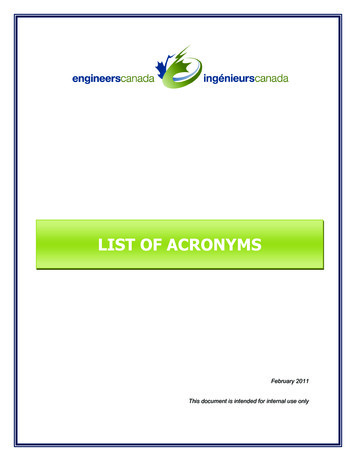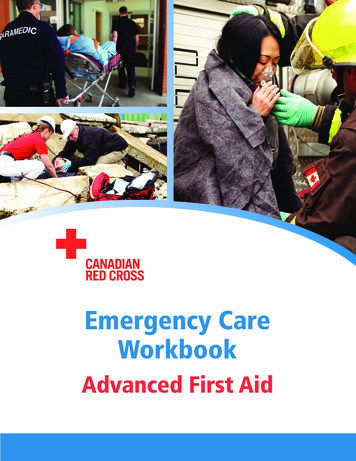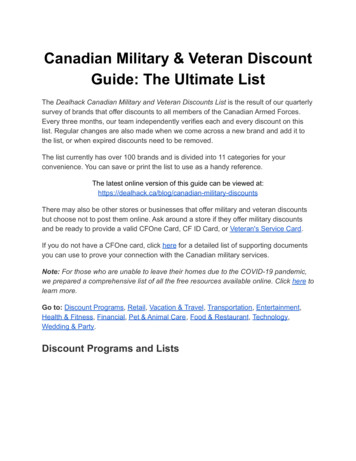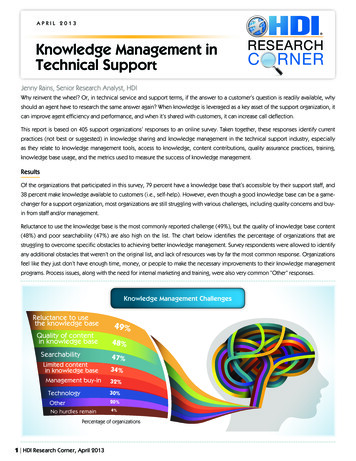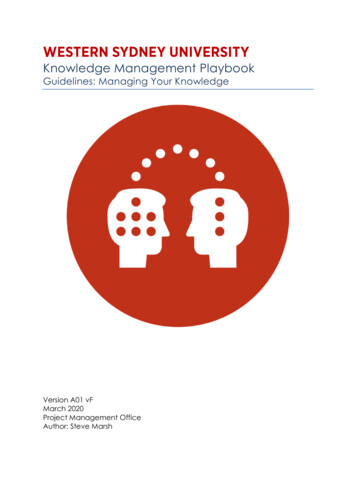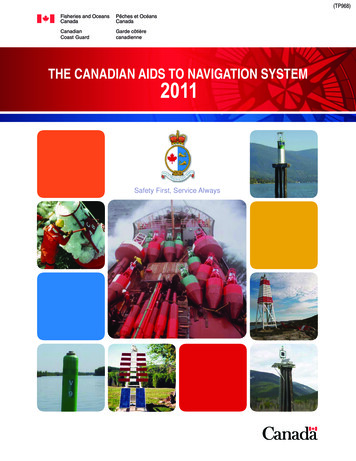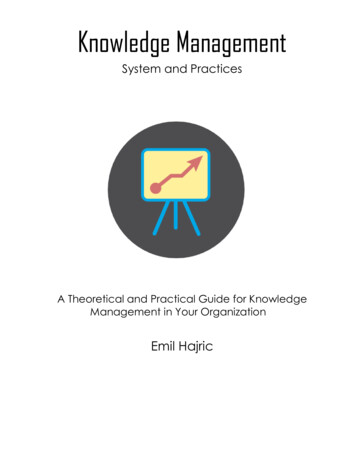
Transcription
The Canadian Knowledge Management System (KMS) within the Land ForceCommand and Control Information Systems (LFC2IS)Topic: Decision Making and Cognitive AnalysisAuthors:Dr. Pierrette ChampouxPoint of ContactDMR Consulting, A Division of FUJITSU Consulting2960 Blvd Laurier, Office 400,Sainte-Foy, (Quebec) Canada, G1V 4SI(418) 653-6881 (6190)email: Pierrette champoux@dmr.caMajor Joe CostelloDirectorate Land Command and InformationDepartment of National Defence101 Colonel-By Drive, Ottawa, (Ontario) Canada, K1A 0K2(613) 992-5451email: costello.jp@forces.gc.caSonia BourgetDMR Consulting, A Division of FUJITSU Consulting2960 Blvd Laurier, Office 400,Sainte-Foy, (Quebec) Canada, G1V 4SI(418) 653-6881 (6013)email : sonia bourget@dmr.ca
1.AbstractThis paper will present an overview of the Knowledge Management System (KMS) project historyand the system functionalities. It will show how the KMS permits the Canadian Forces to synchronizelessons learned, doctrine and system help and to manage its knowledge and exploit it, either as aknowledge management process or as assets that can be used independently.2.IntroductionThe Knowledge Management System (KMS) is the result of substantial research and developmentefforts undertaken by the Department of National Defence (DND), DMR Consulting1 and DRDCValcartier regarding Knowledge Management, Lessons Learned Process, Electronic Task SupportSystem (or EPSS, Electronic Performance Support System), Command and Control, Ontology, etc.The KMS was deployed in October 2004 as “One System” of the Land Force Command and ControlInformation System (LFC2IS) to support specific requirements within a “System of Systems”development context where the challenge is to integrate different systems that were individuallydesigned and developed into an infrastructure [Cantin, 2004]. The KMS encompasses two systemspreviously developed for the Canadian Forces (CF), the Army Lessons Learned KnowledgeWarehouse (ALLKW)2 [Champoux 2003] and the Electronic Task Support Framework (ETSF), aimingto enhance the capability to manage and generate more knowledge faster and more accurate insupport of individuals, groups, teams and organizations; the aim being to gather/capture: What the individual knows; What others know; What the CF knows and how it can use this information and apply it in a more simple andefficient manner.The main purpose of the KMS is to provide the Canadian Forces with a tool for managing KnowledgeAssets and the Knowledge Management Process while remaining focused on business process (e.g.Doctrine, Lessons Learned). It also aims at focusing, providing, producing and managing informationfrom different sources enabling a validation process of the information it supplies. The system maybe foreseen as the Knowledge Management portion of an Enterprise Knowledge Portal [Firestone1999], [Firestone, b 2003], [Collins, 2003].The Army’s intent is to use the KMS to standardize how system help is developed within a wholebody of systems (e.g. LFC2IS) and to provide a tool to system help users, within the context ofintegrating declarative knowledge from Doctrine and Tactics, Techniques and Procedures (TTPs) aswell as Procedural Knowledge from Standard Operating Procedures (SOPs) and System Procedures.1DMR Consulting, a division of Fujitsu Consulting.2The system recently won the highest Canadian recognition in the IT domain (November 2004). Canadian InformationProductivity Awards (CIPA) has awarded four prizes to the project, the Canadian IT project of the year, which are theDiamond Award of Excellence, the Silver and the Gold in the Efficiency & Operational Improvements category as well asthe CIO of the year Award to Lieutenant Colonel Jacques Hamel. It had previously won an OCTAS (April 2004) from theQuebec Provincial IT industry in the E-learning and Knowledge Management category.2
KnowledgeOrganizationKnowledgeGatheringKnowledge inActionKnowledgeAnalysisFigure 1. Knowledge Management Process3.KMS Overview3.1 Origin of KMSManaging assets and the Knowledge Process were embedded into the LLKW implemented in April20032. It mainly focused on supporting the entire Knowledge Management Process regarding LessonsLearned (LL) (Figure 1) [Bourry-Brisset, 2002], [Champoux, 2003]. The LL Process (LLP) is among the“Best Practices” in Knowledge Management [Davenport, 1998], [Weber, 2000], [Aha, 2001] and is astrategy to elicit, retrieve and re-use lessons acquired from experiential knowledge. The Army LLPwas designed during the course of the project with the extensive participation of users [Maclean,2005] in several Joint Application Development sessions (JAD) [Cantin, 2004]. The Canadian Forcesagreed upon the composition of the LLP and is currently pursuing the development of a CanadianForces Lessons Learned Knowledge Warehouse (CFLLKW) using KMS as a framework, leveragingthe work undertaken by the Army and making it a multi-environment system where knowledge willbe shared consequently enhancing a learning curve that will benefit everyone.The Electronic Task Support Framework (ETSF), deployed in April 2004, provides tools to structureknowledge and manage explicit relations between objects that can be mapped to present thecontextual help in relation to a system user performing a task. A study of how doctrine, TTPs andSOPs should be structured was undertaken in order to analyze the different schemas under which thedeclarative and the procedural knowledge are best represented or managed as distinct objects.Within the LFC2IS context, knowledge is organized in such a way that it provides the militarypersonnel (operators) with easy access to knowledge and most importantly prompts them, uponrequest from a specific system, with what is truly relevant to their specific tasks while keeping inmind that time (both reaction and response time) is a sensitive issue in decision making. The systemalso allows users to navigate and search through the body of knowledge gathered either within orregardless of the domain.3
As all LLKW functions, all ETSF functions are part of the KMS; the System Help domain is fullyintegrated and synchronized with the Doctrine domain (including TTPs and SOPs) offering theCanadian Forces a complete top-down view on knowledge as well as the right information in atimely fashion to the person requesting it. In order to facilitate learning and training within a solesystem, the KMS offers a coherent and homogenous System Help framework to systems (e.g. LFC2IS)that were designed and developed on an individual basis.3.2 Knowledge DomainsThe KMS assists the CF throughout the Knowledge Management Process in managing severalknowledge domains such as the Doctrine, Lessons Learned and System Help domains (Figure 2).Specific groups of Subject Matter Experts (SMEs) within organizations will structure and managetheir knowledge by tracking the changes directly from military feedback, through issuesdetermination and recommendation for action and by validating that the changes have made adifference. For instance, a specific CF organization may have the responsibility to manage a subset ofArmy Doctrine within the Doctrine domain; another may manage Lessons Learned from a tacticalperspective within the Lessons Learned domain or manage all system helps related to a specific‘System of Systems’, such as the LFC2IS within the System Help domain.EnvironmentOrganizationsJointNavyAir ForceArmyDoctrineLessonsLearnedSystemHelpKnowledge DomainsFigure 2. Organizations from Environments responsible ofmanaging knowledge within a specific domain4
The three main Knowledge Domains of the KMS regroup knowledge in terms of business purposeswithin groups or organizations. They are defined as follows:a. Doctrine. This domain manages knowledge regarding the “fundamental principles by whichthe military forces guide their actions in support of preset or current objectives.”[AAP-6NATO]. The doctrine in KMS is managed as a distinct knowledge object for each topic thatcan be shared and linked when needed, thus reducing knowledge redundancies that createinconsistencies. As a result, a specific topic may be defined once and re-used throughout thedifferent Doctrine Knowledge Structures. The KMS manages knowledge objects instead ofdocuments, however the concept of publications within the system allows the user the optionto extract documents, as deemed appropriate.b. Lessons Learned: This domain manages current and historical data gathered from activitiessuch as Operations, Exercises, Experiments and Trials. Within this knowledge domain,observations and comments, considered as raw data, are gathered and organized through aset of Observation Structures (e.g. questionnaire). This domain aims at enabling the CF toprofit from its own experiences thus avoiding the duplication of costly errors, particularlythose pertaining to death or injuries. It will also help to achieve success and provide aconsistent trend towards enhanced performance while favouring a better and permanentlearning curve for the users.c. System Help: This domain gathers and manages knowledge regarding “On-Line Help” for allLFC2IS applications and for KMS as a whole. This domain offers a coherent and homogenousframework for the development of System Helps of Systems. The different System Helps maybe fully integrated and synchronized within the Doctrine domain, thus offering a completetop-down view on knowledge as well as the right information at the right time to the rightperson.In order to address the CF priorities regarding Knowledge Management, many stakeholders (Figure3) are involved in the development of the KMS and its content. The Canadian Forces Lessons Learnedorganizations involved are the Army Lessons Learned Centre, the 1 Canadian Air Division (1CAD),the J7 Operational Analysis and Lessons Learned and Lessons Learned Maritime Warfare Centre.From the System Help and Doctrine domain’s perspective, the organizations involved are theDirectorate Land Command Support Program Management (DLCSPM), the Directorate ArmyDoctrine (DAD) and the Army Digitization Office Kingston (ADOK) overlooking the managementand the definition of Doctrine, TTPs, SOPs and System Helps.5
Lessons Learned DomainEnvironmentsAir ingSystem Help DomainDoctrine FDTSOrganizationDLCSPMDADADOKLFC2ISSystemSub SystemsOperaATSKMS Figure 3. Stakeholders of the KMS Project3.3 Knowledge Process and AssetsThe KMS’s main objective is to empower the Canadian Forces with a tool to create as many domainsand sub-domains as required for groups or organizations that need to have control over knowledgeassets and their own Knowledge Management Process enabling them to: Structure their body of knowledge more efficiently; Manage explicit relationships between knowledge objects; Share knowledge with one or many groups; Gather, receive and capture observations, comments and feedback from key participants onspecific subjects or topics; Raise issues; Identify requirements or lessons; Track any action taken on issues; Validate that the lessons are learned and the effect of actions taken on outcomes.The KMS may be considered as a tool that supports a Knowledge Management Framework [Gorelick2004, Firestone a 2003] addressing knowledge as a process (Figure 4 A) and as a multitude of assets(i.e. stock or entity) (Figure 3 C) but most importantly it is a tool permitting knowledge managementin both aspects.Sharing is one of the most important factors of success of any KM initiatives and in that regard, theKMS allows any CF personnel to give ‘Feedback’ (Figure 4 B) on any asset of any domain. Feedbackmay take many forms, comments or suggestions, covering various subjects such as enhancementpurposes, new functionalities, and examples or best practices. For instance, it may be additionalinformation on a specific Exercise that was overseen.6
The first priority of the Canadian Forces regarding Knowledge content concerns Activities (e.g.Operations, Exercises) as well as System Help and SOPs for LFC2IS and secondly comes Doctrine andTTPs, which are already in progress. The actual content of the KMS consists of the following: Observations and comments gathered through the Chain of Command for each specificactivity pertaining to Operations/Rotations, Exercises and Experiments/Trials. Doctrine where “fundamental principles, by which the military forces guide their actions insupport of objectives”[AAP 6, NATO] are defined for guidance; Tactics, Techniques and Procedures that prescribes in more detail how military activities areplanned and executed. Standard Operation Procedures that define “a set of instructions covering features ofoperations which lend themselves to a definite or standardized procedure without loss ofeffectiveness. The procedure is applicable unless ordered otherwise” [AAP 6, NATO]. System Procedures that support the SOP’s related to specific military tasks.Canadian Forces Knowledge Management dgein k from CF sesExperiments/Trials CDoctrine toTTPsTrainingPlanSystem HelpFigure 4. Knowledge Management as Process and Assets3.4 KMS usage within the LFC2IS contextThe KMS also provides to users of systems, such as LFC2IS, an access to a standardized help withinspecific knowledge from Doctrine, TTPs and System Procedure, which is linked and presented toLFC2IS users to address their tasks.7
From a system users perspective, the KMS supports and enhances users’ performance by providingthem with the body of knowledge required by the task they are actually performing at the time of therequest (just in time). As a result, the user has access to the most appropriate knowledge to addresshis task, which is embedded into KMS (e.g. Doctrine, TTPs, System Procedures). This knowledgedelivery has strategic implications in the training and in its subsequent adaptability to changes. It isrecognized in the scientific literature that when the user of a system is adequately guided by thesystem itself towards the knowledge he needs to accomplish the task, the main result is a significantreduction in training requirements [Cole, 1997], [McGraw 1997].From a system development perspective, the KMS provides an integrated framework for thedevelopment of System Help whereby systems developers and Subject Matter Experts capture andintegrate knowledge from a system’s perspective such as system procedures and steps and from abusiness perspective such as Business Process, Sub-Process and Task. Most importantly they aremanaging explicit relationships within the body of knowledge of the KMS (e.g. doctrine, Lessons).The KMS offers a single point of entry to access System Help of a ‘System of Systems’ such as theLand Force Command and Control Information System (LFC2IS).4.Knowledge Management Process within the KMSThe Knowledge Management Process (KMP) supported by KMS is composed of four main phases:Knowledge Organization, Knowledge Gathering, Knowledge Analysis and Knowledge in Action(Figure 5), under which several sub-processes manage different knowledge assets and aspects of thesystem. Some assets may be associated to one or more phases of the KMP such as the issue raised byKnowledge Analysts are determined in the Knowledge Analysis phase and are conducted in theKnowledge in Action phase. Figure 5 presents the KMS Assets in light of the KM owledgeGatheringK-SchemaReportsKnowledge ackDocumentsKnowledgeAnalysisIssuesLessonsLessons LearnedRequirementsFigure 5. KMS Knowledge Assets in relation with the Knowledge Management Process8
All domains and sub-domains follow the KMP in light of their respective knowledge assetsresponsibilities. As a result, the KMP involves many users that have specific roles. With the use ofapplication roles (Figure 6), the KMS facilitates the management of accessing and editing rights toknowledge within a domain or a sub-domain.ManageActivityAdd FeedbackReaderAdd Observationsand icipantManageKnowledgeAdd FeedbackLFC2ISUserAccess SystemHelp in eLessonAdd IssueRecommendationDirection, torFigure 6. KMS Knowledge Application Roles4.1 Knowledge OrganizationThe aim of this phase is to organize and structure knowledge for each knowledge domain and subdomain in such way that it can be easily visualised, searched and managed. The KMS supports twoways of accessing the knowledge of a specific domain: By navigating through different Knowledge Structure; or By searching within the domain.A Knowledge Structure (Figure 7) provides a hierarchical display of knowledge that may becharacterized as a subject, a topic, a process, a task, a procedure, a step, etc. For example, within theDoctrine domain there is a breakdown of processes that will present all processes, sub-processes,tasks and procedures.OrganizationEnvironmentKnowledge SchemasFeedbackStructureStructure WorkBreakdown StructureObservationsFactual Structure IssuesLessonsCommentsActionsRequirementsKnowledge SchemasWork Breakdown StructureFactual igure 7. Knowledge Component of a Domain or sub-domain managed by an organization9
A Knowledgedefining: Structure follows a set of rules that is referred to as a Knowledge Schema (Figure 7)How knowledge is characterized (e.g. topic, process);How it is organized within a hierarchy (e.g. process may task or sub-process);The possible relations within the schema, between schemas and with other knowledgeobjects such as lessons, issues or recommendations.The KMS support multiple schemas shared between domains and sub-domains. Within the KMS thedeclarative knowledge (e.g. Doctrine) are regroup under Knowledge Structures as the observationsand comments gathered from participants of specific activity are linked to Observations Structures(Figure 7).The KMS allows the use of multiple Observations Structures that may be based on questionnairesschema (or other) for different categories of activities (e.g. International Operations, DomesticExercises).The KMS also manages explicit relationships (Figure 7) between assets such as documents, issues orlessons may be linked to activities: Operation, Exercise, etc.4.2 Knowledge GatheringThe main objective of this phase within a domain or a sub-domain is to manage observations,comments and feedback in relation to activities. This phase is the entry point of the militarypersonnel (participants) involved in this activity.The participants of Operations or Exercises are able to capture their observations and comments “online” following a specific Chain of Command and attached specific documents related to theactivities. These are considered by the Canadian Forces as “Official Reports” that are approved bythe Chain of Command. Observations and comments are captured on-line by contributors andapproved by the Commanding Officer for each organization associated to a specific Reporting Level.The distinction between observations and comments allows users to easily visualize and follow adiscussion on a particular subject within the context of an operation or an exercise. The sequence ofobservations and comments follow the Chain of Command from the Unit level up to the higher level.One of the benefits of the on-line capture of knowledge is the possibility to access observations andcomments as soon as the Commanding Officer has approved his knowledge acquisition.The KMS also allows any military users to add feedback on any particular assets. For instance, a usermay want to add an observation regarding an Experiment, Doctrine or a system procedure.10
4.3 Knowledge AnalysisThe next two phases are part of the Tracking Knowledge Mechanisms that foresee the validation anddissemination of information within the KMS.The main objective of the Knowledge Analysis phase is to seek knowledge on different topics,validate issues and enhance learning while performing activities (e.g. operations, exercises). Thisphase is the entry point of a wide range of users that are interested in learning about previousexperiences and increase their state of preparedness for operations or training.The Officers of Primary Interest (OPI) of a specific knowledge domain manages all feedback orobservations (i.e. through questionnaires) ensuring that all are addressed, analysed, and that eachrelevant issues is raised and sent through the Chain of Command. They are also responsible toidentify lesson.The Subject Matter Experts (Knowledge Analyst) of each domain decide which explicit relationshipsbetween assets from different domains need to be managed, shared and pursued throughout theenvironments, as deemed appropriate. The KMS offers different views of the same knowledgewithout duplicating it so that multiple knowledge structure schemas can be used to organize theknowledge in light of the user’s perspective for either learning, training on current applications or tosupport activities such as operations or exercises.The KMS is a unique collaborative environment where military personnel can manage and sharetheir knowledge among different domains as well as domains of different environments. The systemenables the users to find rapidly and easily what is required, it may prompt knowledge in context ofa given task and allow the user to add their own feedback taking into account their valuableexperience and expertise.4.4 Knowledge in ActionThe main objective of the Knowledge in Action phase is to gather recommendations and decisionsfrom staff authorities, ensuring that proper actions are taken and lessons are learned. This phase isthe entry point of the stakeholder, OPI, Staff, Commander and Lessons Learned Organization Staffwhose main concern is to follow up on actions but also contribute to the KMS by adding theircomments, recommendations or decisions on issues that falls under their command.The Follow-up on action is required to validate changes, to verify if a lesson has been learned or tosimply correct/modify or change specific topics of the doctrine.Therefore, KMS enables domain OPIs to track action taken upon issues. The KMS allows: OPIs (Tracking Contributor) to capture “on-line” their recommendation, direction ordecision on specific issues. Knowledge Analyst to create and manage multiple Status Reports regrouping severalissues of a specific domain.11
5.Impacts of KMSThis whole process did not happen overnight. It took time to convince a lot of people at differentlevels that what was developed had a purpose and a very important one indeed. This “vision” had tobe presented, acknowledged and eventually shared among many participants before it became a“System of Systems” type of project. Again, time was a sensitive issue.The way of doing things have changed over time, thanks to the e-tools that are offered on the marketbut also because, ultimately, time should be considered a valuable issue/asset in decision making.Our workforce is aging rapidly and their knowledge needs to be captured so that the next generationwill not have to repeat the same process of errors, results, lessons learned and change of attitudetowards problems that they will encounter. Our learning curve needs to adapt rapidly to changes andwe feel that the KMS will provide a valuable solution for the next generation, ultimately enabling usto save lives by making the right decision at the right time. As groups may evolve throughout theacquisition of a KMS, whatever the development and direction it should take, keep in mind that bothreaction and response time are sensitive issues and that they, from an economical point of view, havea strong monetary impact on the outcome, much stronger than the costs involved in implementingsuch an approach.The fact that the new generation is much more familiar with computers is a plus that needs to beexploited for the benefits of organizations. Contrary to some beliefs, the “old ways of doing things”will not be jeopardized by the acquisition of a KMS System of Systems: it is more likely to be theopposite as the value of the knowledge embedded within each individual will be captured in theSystem, thus challenging those who have put this information in to “push the envelope further.” Thisis called innovation; it should not be scary: it should stimulate creativity within groups. It may alsoenable people to discover within Forces, a group of individuals that are starving to “make it happen”as was seen within the CF.6.ConclusionKMS is a tool that enables organizations to centralize their knowledge. Yet it also compartmentalizesit in terms of ownership facilitating its management and its use from different perspectives accordingto who uses it. The information in KMS comes full circle since the CF exploits it as part of itsknowledge management process. However, it need not stop there, and it doesn’t, since each bit ofinformation can also be exploited as a stand-alone. By linking one bit of information to another,which does not necessarily follow one another in the KM process, a better idea of what the situationis can be given. Creating those links and adding additional relationships between chunks ofinformation draw a clear picture of the real world. You need only go back to it to remember how itwas, how it is now or to see what is planned for the future.This project was born from the passion of dedicated individuals. As you have noticed over the years,passion is a driving force if you want to make a success of what you implement. More importantly, tobe a winner you need to surround yourself with what is necessary to be the best, especially whenbeing on top of your game can save lives!12
7.AcknowledgementThe Directorate Land Command Information, National Defence Headquarters Canada, sponsoredthis project.8.References[Aha 2001] 16] David W. Aha, Rosina Weber, Héctor Munoz-Avila, Leanard A. Breslow, Kalyan MoyGupta, Bridging the Lesson Distribution Gap. IJCAI'0, Seatle, WA August 2001, Morgan KaufmannPublishers, Inc. pp. 987-992.[AAP-6 NATO] AAP-6 NATO Glossary of Terms and Definitions[Boury-Brisset, 2002], Boury-Brisset, Anne-Claire, Marlène Gauvin, Pierrette Champoux. AKnowledge Management Approach to the Creation and Sharing of Canadian Forces Lessons Learned,ACBB MG PC- Lessons Learned –ICCRTS September 2002, 17p.[Cantin, 2004] Cantin, M, and G. Thibault. The info-Centric Collaborative Workspace from a SystemPerspective. 9th ICCRTS Sysmposium Proccedings about The Power of Information Age Concepts andTechnologies, September 2004, Copenhagen, DK, Unclassified.[Champoux, 2003], Champoux P, Gaetan Thibault, Martin Trudel, A Lessons Learned KnowledgeWarehouse to Support the Army Knowledge Management Command-Centric, Information SystemTechnology Symposium, Military Data and Information Fusion, Prague, Czech Republic, October 2022, 2003[Cole, 1997] Cole Kevin, Olivier Fischer, Phyllis Saltzam. Just-in-time Knowledge Delivery,Communications of the ACM, July 1997, vol. 40. no. 7.[Collins, 2003], Collins H. Enterprise Knowledge Portals, Next-Generation Portal Solutions for DyanamicInformation Access, Better Decision Making, and Maximum Results, American Management Association(AMACOM), 430p.[Davenport, 1998] Davenport T. H. and L. Prusak. Working knowledge: How organizations manage whatthey know. Boston, MA: Harvard Business School Press, 1998.[Golerick, 2004], Golerick Carol, Nick Milton and Kurt April. Performance Through Learning KnowledgeManagement in Practice, Elsevier Bturrerworth-Heinemann, 408p.[Firestone, 2003 a] Firestone J. M. (2003), Mark W. McElroy. Key Issues in the New KnowledgeManagement, Knowledge Management Consortium International, 350p.[Firestone, 2003 b] Firestone, J.M., Enterprise Information Portals and Knowledge Management,Knowledge Management Consortium International, 422p.[Firestone, 1999] Firestone, J.M. Enterprise information Portals and Enterprise Knowledge Portal, DKMSBrief 8, Executive Information: Systems, Inc,, Wilmington, DE, March 20, 1999[McGraw 1997], McGraw Karen, Defining and Design the Performance –Centered Interface, MovingBeyond the User-Centered Interface, ACM, Interactions March-April 1997.[Maclean, 2005] Maclean Susan, Diamond in the rough, CIO Magazine, February 2005, pp10-15.[Weber, 2000] Rosina Weber, David W. Aha, Irma Becerra-Fernandez. Intelligent Lessons LearnedSystems. International Journal of Expert Systems Research & Applications, Vol. 20, No.1., pp. 17-34.13
The KMS may be considered as a tool that supports a Knowledge Management Framework [Gorelick 2004, Firestone a 2003] addressing knowledge as a process (Figure 4 A) and as a multitude of assets (i.e. stock or entity) (Figure 3 C) but most importantly it is a tool permitting knowledge management in both aspects.


